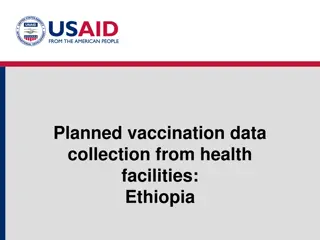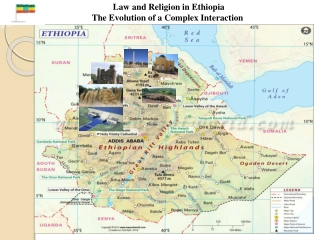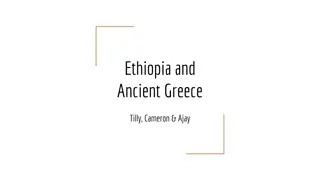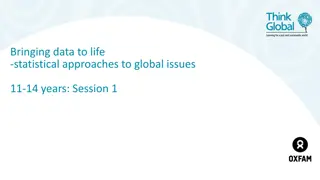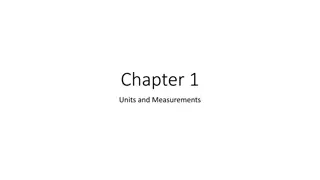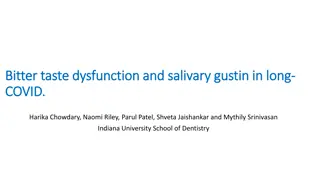Impact of COVID-19 on Essential Health Services in Primary Health Care Units of Ethiopia
A study conducted by health leaders in Ethiopia explored the response of primary health care units to COVID-19 and its impact on essential health services. Findings revealed challenges faced by the healthcare system due to the pandemic. The study highlighted the disruption of services and the need for adaptations to ensure continued access to healthcare during the crisis.
Download Presentation

Please find below an Image/Link to download the presentation.
The content on the website is provided AS IS for your information and personal use only. It may not be sold, licensed, or shared on other websites without obtaining consent from the author. Download presentation by click this link. If you encounter any issues during the download, it is possible that the publisher has removed the file from their server.
E N D
Presentation Transcript
Impact of COVID-19 on essential health services in primary health care units of Ethiopia Getnet Mitike (MD, PhD), Frehiwot Nigatu (MD, MPH), Eskinder Wolka (PhD) Atkure Defar (PhD), Masresha Tessema (PhD),Tizita Nigussie (MPH,MSW) International Institute for Primary Health Care-Ethiopia and Ethiopian Public Health Institute GHPC Bethesda 3 5 October 2022
Background [1] Ethiopia is the second most populous country in Africa The health system is decentralized Has a three-tier referral system A PHC unit consists of five health posts, a health center and a primary hospital
Background: Ethiopia [2] Population >123 million Population growth rate 2.57% Nine Regional States Two City Administrations 80% live in rural areas Life expectancy 67 years
Background [3] - District (Woreda)Health Care: PHC system vs Administrative levels
Background [5] COVID-19 First case of COVID-19 was reported on 13 March 2020 Prior to the report: containment measures and trainings were underway By September 2020: 75,368 cases and 1,198 deaths occurred Objective To explore how primary health care units in Ethiopia responded to COVID-19 and the impact on essential health services.
Methods [1] We conducted a qualitative study: exploratory/KII. A total of 59 health leaders across regions purposively selected. Covered all regions (10) and two administrative cities. Data were collected using a semi-structured interview guide. Interviews were conducted in person; transcribed. Transcripts coded, categorized and themes developed; Thematic analysis.
Results (Key findings) and discussion: Out of 60 expected; 59 were interviewed. Mean age was 35 years. Majority (89.9%) were male. Nearly half (47.5%) of the participants held a baccalaureate degree (health officers, nurses, and other degrees). 44% percent were providers in health facilities. Service years ranged from 2 to 40 years.
Results (Key findings) and discussion: [1] Three Themes 1) Impact on Essential Health Services Six subthemes: a) Impact on service utilization, b) Impact on service delivery, c) Services affected by COVID-19, d) Impact on health outcomes, e) Impact on the health workforce, and f) Measures taken to maintain essential health services 2) Participants Assessment of COVID-19, and 3) Challenges to COVID-19 response and resilience.
Results (Key findings) and discussion: [2] Theme 1. Impact on essentaial health services a) Subtheme: Utilization of essential health services Considerably declined in the first few months after COVID-19 was confirmed in Ethiopia. Since we focused on prevention and management of COVID-19, it has affected the delivery of essential health services. For instance, in our health centre, we had more than 400 cases of hypertension on follow up. After the introduction of COVID-19, we lost many of these patients Similarly, we have lost many HIV positive patients to follow-up. (TG_HF_1) (Elston, 2016 experience from Ebola)
Results (Key findings) and discussion: [3] b) Subtheme: Impact on health services delivery: When the pandemic occurred, other priorities were neglected; the focus was almost exclusively on COVID-19: The concern of the leaders was that we will lose lives due to coronavirus. Corona will kill all. So, we have to focus only on corona: no agriculture, no peace and security, and even no politics. (AF_RHB_2) When the condition became worse, all the suppliers doubled the price of basic medical resources. You will be surprised; the medical suppliers in the private sector raised their prices 10- to 15-fold compared with the government suppliers . (AM_HF_2)
Results (Key findings) and discussion: [4] c) Subtheme: Type of services affected by covid 19 MCH and services to NCD patients was affected: for example, we used to admit malnourished children. There will be many defaulters among them because we don t admit. The other one is ANC, ANC-4 has declined. Mothers used to come to the health centre starting in their first term until about one week before their deliveries. They used to stay in the maternal waiting room and deliver here. That has declined. And even family planning. These are the three affected service areas. (AF_HF_1). (Abdela, 2020;,Ethiopia; Kimani 2020; Ahmed 2020, Kenya Nigeria, South Africa).
Results (Key findings) and discussion: [5] d) Subtheme: Impact on health service outcomes The decline in essential health service utilization and delivery profoundly impacted women and children. Many participants spoke about an increase in home births, which had previously been on a downward trend, and linked home births to maternal and new-born deaths. Participants from three regions (Afar, Tigray, and Amhara) witnessed an outbreak of measles due interruptions in the vaccination program and in two other regions (Sidama and Harari) saw a rise in SAM.
d) Subtheme: Impact on health service outcomes (continued) . ..But I can tell you what I know. For example, a mother called for an ambulance service after she gave birth at home After a ruptured placenta, she arrived at our centre with post-partum haemorrhage and we referred her to Hawassa Rereferral Hospital, where she died. The Hawassa city administration and Millennium Health Centre have information about maternal deaths. There were no maternal deaths recorded in the last two years. But after COVID was detected in our city, we registered the case that I just mentioned. Even though we cannot describe the consequence in numbers- because we don t have the data, we know there are unnecessary deaths. (SID_HF_1)
Results (Key findings) and discussion: [6] e) Subtheme: Impact on the health workforce Redeployment of health professionals When we look at human resources, after the introduction of COVID, four or five staff were moved from the health centre to screening and treatment centres. So, this was challenging for us. Reducing our workforce by four or five people at a time of high workload was really challenging. Despite this fact, there were no new staff recruited by the health bureau. (TG_ HF_2)
Results (Key findings) and discussion: [7] f) Subtheme: Measures taken to maintain essential health services A few months into the pandemic, the danger of neglecting essential services became clear. Then after about three months, by assessing the impact of COVID-19 on essential health services, we found that death from non-COVID morbidities was greater than COVID-19 deaths. Therefore, a guideline was developed to work on both COVID and non-COVID activities, side by side. (BG_RHB) (WHO, 2022)
Results (Key findings) and discussion: [8] Theme 2. Participants assessment of COVID 19 There was a good multi sectoral collaboration at the beginning that declined later Participants perceived that the health system s preparation for and the response to the pandemic was inadequate and hence impact on essential health services was noticeable. our preparation was not satisfactory. The readiness of health facilities on prevention and response was not satisfactory. Health facilities were not well equipped with drugs, supplies, and health care providers. These are among the weaknesses. (SN_RHB)
Results (Key findings) and discussion: [9] Theme 2. Participants assessment of COVID 19 (continued) Major strengths: staff commitment, sense of common purpose, and spirit of collaboration across sectors o Staff worked 24 hours, often without additional compensation o Hierarchies broke down as high level officials engaged in awareness creation o Academic institutions, non-governmental organizations, businesses, security forces, and private citizens aided the effort through technical and material support Observed weaknesses: limited budget, space, supplies and equipment, and personnel; poor leadership and management; and decline in multisectoral collaborations
Results (Key findings) and discussion: [10] Theme 3. Challenges to the covid 19 respose Health officials also feared that the end of the state of emergency gave community members the impression that the pandemic was no longer a threat. Nowadays, a great challenge is the ending of the state of emergency - people are saying there is no COVID-19 anymore. Previously, transportation was at half capacity, you were not allowed to walk out without a face mask, social distancing was mandatory, etc. But when the state of emergency was lifted off, there was no new direction set. Then people are not trusting health professionals, they are telling us that COVID does not exist. This type of attitude is a great challenge. (SN_WoHO)
Conclusion Sub-national health structures waged a swift and coordinated response to COVID-19 at the start of the pandemic. Response was strained from the beginning due to a shortage of health workers, space, equipment and supplies and began to fray as the pandemic worsened. Multisectoral collaboration declined within six months of pandemic, leaving health sector to shoulder response with limited resources. Local health systems also failed to take account of and maintain essential health services, potentially derailing progress made in maternal and child health, HIV/AIDS and tuberculosis.
Recommendation As the number of infections in Ethiopia rise, we recommend: reengaging local administrations and actors outside the health sector, including academic institutions and local businesses, in the response effort; strengthening resource mobilization for COVID supplies and equipment; improving testing capacity across the country; collaborating with local media and community leaders to dispel public misconceptions about COVID and strengthen community adherence to prevention measures; Learn from this experience and build capacity for similar challenges.


